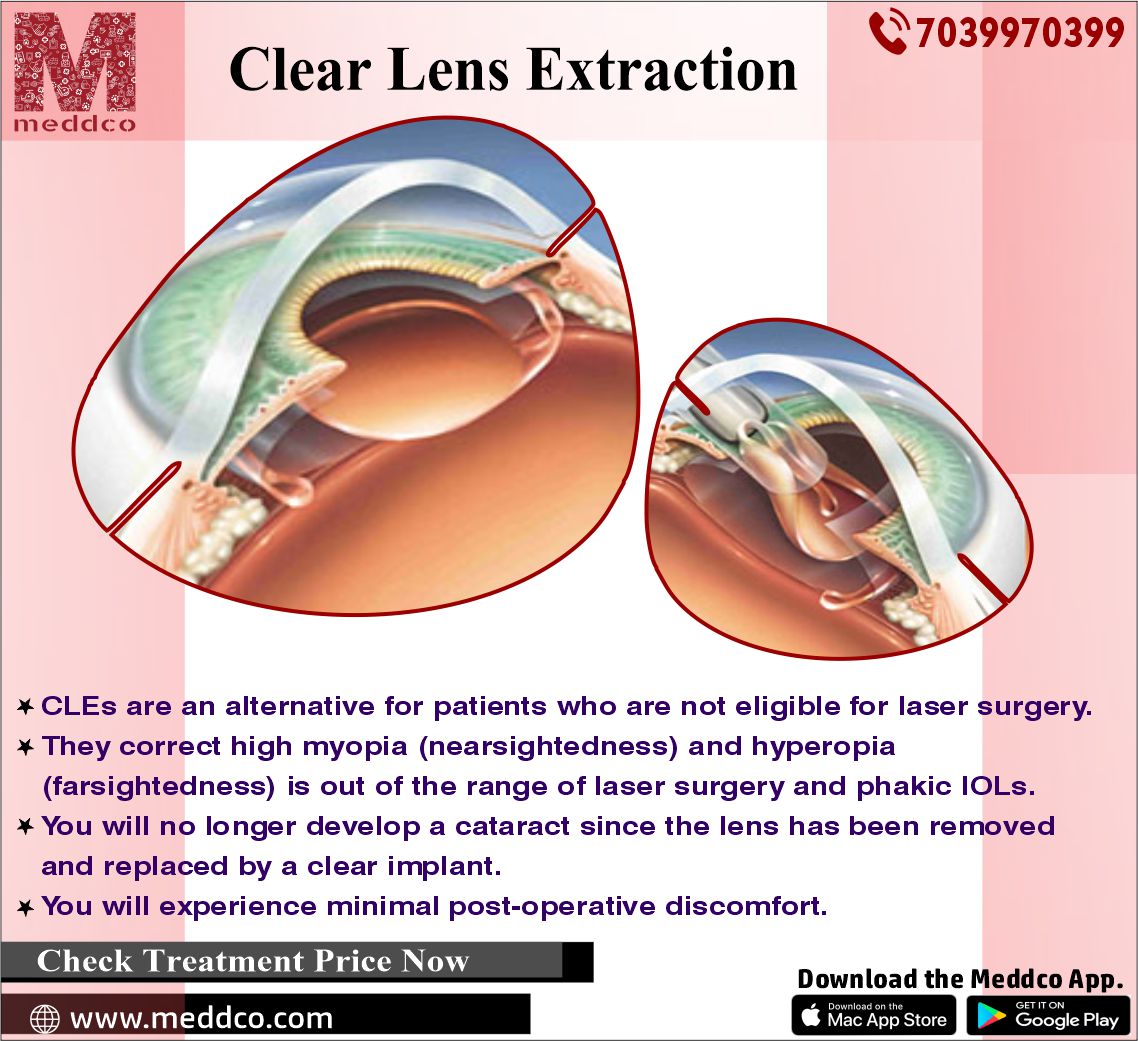

: Admin : 2022-06-11
What if LASIK isn't an option for you due to your high levels of myopia, hyperopia, or dry eyes? In that case, you might want to look at Clear Lens Extraction as an alternative. When the natural lens has grown cloudy and obstructs vision, a procedure known as Clear Lens Extraction (CLE) is used to remove it. The main difference between CLE and cataract surgery is that the natural lens is still evident. CLE, like LASIK, is a sort of refractive surgery that uses a different surgical approach to achieve the same results.
What is Clear Lens Extraction?
When the standard lens of the eye is removed and replaced with an intraocular lens (IOL), it is known as a "clear lens extraction" (CLE). The eye's clear lens is removed and replaced with an IOL to alter the eye's focusing capacity, just as in cataract surgery.
Candidates for the extraction of Clear Lenses
Precise Lens extraction is helpful for people :
The advantages of using a clear lens
Another option is the Clear Lens Extraction (CLE) to treat patients whose corneas are too thin for laser vision correction; another option is the Clear Lens Extraction (CLE).
A few of the benefits of RLE include:
INSTRUCTIONS FOR THE PROCESS
After arriving at the surgical centre for your operation, you will be allowed to ask any additional questions you may have. It is the moment for additional testing, if necessary. Read and sign a consent form for surgery and ask any questions you may have regarding it. Your post-operative instructions will be reviewed by a technician, who will ensure you understand them. Avoid wearing any cosmetics or skin creams before your arrival, and dress in a relaxed manner. You will need to bring a friend who can drive you home following your operation. We'll perform an eye drop numbing technique after you've been given a mild sedative to help you relax. Although allergic responses to these drugs are extremely rare, you must let the surgeon or technician know if you have any of these allergies. You will be requested to remove your street clothing before entering the surgery suite for your safety. Once you are situated in the surgical chair, you will be reclined. Only the eye being operated on will be visible due to the placement of a surgical drape. Due to using a topical anesthetic, you will remain conscious throughout the process. An eyelid speculum will be inserted between your upper and lower lids to keep you blinking throughout the process. An ultrasonic instrument breaks up the natural lens into tiny fragments by making a small cut in the sclera (the white of the eye) near the edge of the cornea (the clear, dome-shaped structure surrounding the iris). A suction device might be utilized to remove the lens from the capsule. Lenses are placed into the eye using specialized equipment that polishes and leaves the capsule in place to aid in positioning and support. The incision is then stitched shut and your surgery is over. Most medical treatments may be completed in less than 15 minutes, if not less.
Extraction of the Clear Lenses
Many people can return home the same day following a refractive lens exchange. Many people notice an improvement in their vision right away, and as the brain gets used to the new lens, that improvement will continue. Eyesight will likely remain stable for the patient as long as the lenses are in place to correct vision and prevent cataracts from forming. In most cases, the second eye is treated about a month after the first one has undergone surgery. A patient's eyes, lifestyle, and the IOL used in the treatment will all play a role in RLE's effectiveness. After this treatment, many patients can eliminate their need for glasses or contact lenses, while others may still require glasses for driving or reading purposes.
Complications and risks of a corneal transplant
There is a risk associated with every surgery. The surgeon should know all of your concerns.
Refractive lens exchanges include the same risks and problems as cataract surgery, such as:
Conclusion
Precise lens extraction is an advantage of newer and safer methodologies that have emerged from advancements in cataract surgery. Refractive surgery is a miracle of our modern world. Because cataract extraction is one of the safest treatments available and the best outcomes are more often than not the norm, surgeons are more ready than ever to do the procedure immediately rather than waiting for the cataract to develop. After CLE, the vast majority of patients report that their eyesight is better than before the treatment, which is the primary goal of the procedure. While it is possible to see clearly at all distances with the help of a multifocal intraocular lens (IOL), it may take a while for your eyes to get used to seeing at different distances. It is impossible to "throw your glasses away and never have to see your eye doctor again" with any refractive surgery, even CLE and LASIK. Retinal and optic nerve structures, which are located in the back half of the eye, are not affected by these procedures. Patients should be aware of this before surgery. Just because the front of the eye has altered does not imply that you no longer need regular vision examinations, not necessary for glasses or contact lenses, but rather to monitor the health of your eyes. Systemic problems such as diabetes or ocular disorders such as glaucoma can still affect a person with CLE at 30. It's impossible to have cataracts later on because the natural lens has been removed.) Many of these can significantly impact the retina and its surrounding components.
clear lens extraction cle eye surgery cataract lasik
No Comments